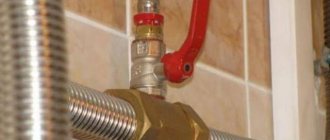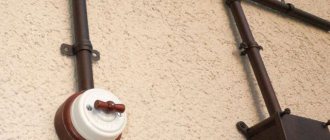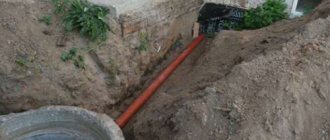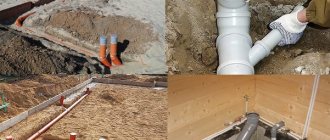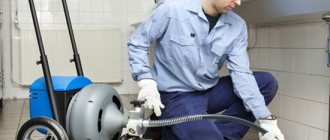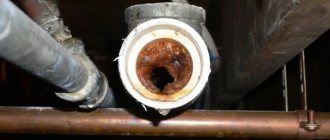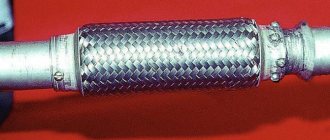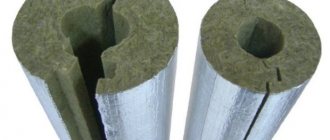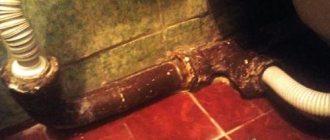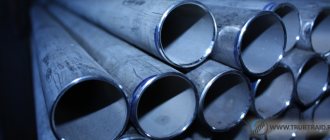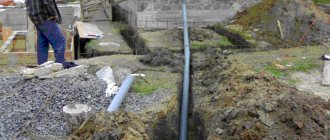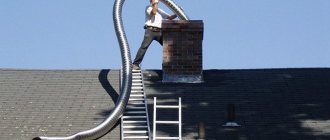PVC sewer pipes: technical characteristics
You may be interested in information about sewer pipe fittings
Products made of polyvinyl chloride - PVC are currently extremely popular on the building materials market (as are soft PVC windows). This material is used to make many useful products, from the familiar disposable gloves to massive structures. Like any plastic, polyvinyl chloride has certain limitations associated with its physical properties. In order to correctly apply all the advantages of this material, for example, when choosing and installing PVC sewer pipes, you need to clearly know its technical characteristics.
PVC sewer pipes for internal sewerage
Characteristics of sewer pipes
Sewage pipes must, primarily for sanitary or environmental reasons, guarantee the tightness of the pipeline. In addition, the selection of pipes depends on the type and volume of waste and the characteristics of the building from which the liquid is drained.
Sewer pipes must have the following properties:
- resistance to mechanical loads of static and dynamic types;
- the ability, when lying in the thickness of the earth, to bear the weight of the soil without bending;
- when installed under roads and highways - resistance to the weight of passing pedestrians and passing cars;
- mechanical strength of connecting nodes, capable of withstanding seasonal or sudden changes in groundwater levels.
It is clear that where the load on the pipes is greater (for example, under a busy highway), pipes with increased strength should be used. Mechanical strength is exactly what distinguishes a red sewer pipe from a gray one: the latter, as it is less resistant to loads, can be used when creating internal sewer contours, and orange PVC pipes are suitable for arranging external areas.
Advantages of gray and orange products
Sewage systems have been made from different materials at different times. These were metal and concrete, ceramic and asbestos products. Today, PVC products are in great demand. They became the main competitors of cast iron and steel structures. Their advantages were:
- high degree of corrosion resistance;
- smooth inner surface (does not clog);
- no exposure to alkalis and acids;
- ability to withstand high temperatures;
- ease of installation;
- lack of electrical conductivity;
- light weight and aesthetic appearance;
- low cost and long service life.
Disadvantages include fear of low temperatures. In cold conditions, products may burst. To combat this disadvantage, manufacturers make multilayer pipes. This increases their strength and resistance to cold. Gray and orange pipes have different characteristics. Orange products are endowed with the best performance. It is used for the construction of external pipelines. Gray products are used for interior work. It fits well into the interior.
Products of inconspicuous color are equipped with appropriate fittings for connecting fragments. With their help, it is possible to create systems of various configurations. Special outlets change the direction of movement of wastewater. Such devices are tees and revisions. The latter help assess the condition inside the pipeline. To do this, you need to unscrew the plastic cover.
The connections are sealed using rubber rings. They provide tightness and withstand the effects of aggressive substances and soil movements. The pipeline in Russian conditions must be insulated. To do this, it is recommended to use mineral wool foil shells. This material appeared recently, but has confidently displaced other means of insulation from the market. It received its unusual name due to the method of application.
The shell performs the following tasks:
- outdoors prevents exposure to sunlight;
- prevents contact of moisture with the surface of the pipe;
- protects the pipe from contact with humans;
- prevents the liquid inside the pipeline from freezing.
It can be in a special plastic casing or covered with foil tape.
The insulation is characterized by low prices and ease of installation. It also has disadvantages:
- the need for precise selection to the diameter of the product;
- some difficulty when used inside a wall;
- presence of seams.
When using shells, glue, tape or wire can be used.
Characteristics of PVC pipes
These products are made from polyvinyl chloride, a polymer material characterized by the following properties:
- fire resistance;
- resistance to low temperatures;
- low melting point;
- light weight;
- increased, compared to polyethylene, rigidity and fragility under strong mechanical overloads;
- inability to conduct electric current, which makes it possible not to use additional electrical insulation;
- chemical resistance to most aggressive environments, including acids, alkalis, salt solutions, oil and gas products;
- no threat of corrosive decay under the influence of groundwater or other liquids.
PVC pipes remain functional when heated to a temperature of 120°C: above this value they lose their shape and begin to emit hydrogen chloride gas, which is harmful to human health.
The first signs of deformation begin below the specified temperature level, when heated to 65-70°C. That is why polyvinyl chloride products are not used to create hot water pipelines.
Advantages of polyvinyl chloride pipes
Red pipes for external sewerage have the following advantages:
- Light weight, which allows, without excessive physical effort and the use of expensive equipment, to carry out both installation and connection, as well as subsequent repairs and dismantling of the system.
- Resistance to mechanical overloads, including impact types.
- A small value of the coefficient of linear expansion when the ambient temperature changes, due to which pipes with drained liquid maintain integrity even when freezing.
- Smoothness of the walls, ensuring the absence or extremely small amount of contaminants adhering during the operation of the sewer system. As a result, there is no need for additional work to clean the circuit, which reduces operating costs.
- Easy to install. To connect polyvinyl chloride pipes, you do not need a welding machine, and sections of the required length can be cut using a regular hacksaw for metal, although the presence of specialized equipment simplifies the matter.
Installation nuances
Installing an external sewer system in your home using socket elements is simple and easy to do with your own hands.
Installation of an external sewerage network
Long external sewers must have inspection wells. The distance between them should not exceed 50 meters; only one turn of the pipeline is allowed between them. This is done so that the system is accessible for cleaning.
Laying is done from the well (or collector, or septic tank).
Features of channel installation
The most labor-intensive part of the work is excavation work. The optimal trench width is 25-30 cm. It is advisable to hire a trench excavator (“bar”). There are also small-sized excavators with trenchers and machines for cutting ditches. You can do it the old fashioned way - by hand. Wide places are excavated near the walls of the house and near the wells; the rest of the trench should be as narrow as possible (saves effort and sand). All turning points must be located in dry manholes large enough to allow a person to descend and operate the turning point.
Sand 10-15 cm thick is poured onto the bottom of the trench, compacted using a tamper, and a slope of 2-8 mm per linear meter is arranged.
How to properly lay sewer pipes in a country house
The socket of the last pipe of the external system must be located inside the foundation and must be insulated. Before joining the two elements, rubber cuffs are lubricated with silicone sealant to increase the tightness.
The pipeline should not bend up or down, and there should not be strictly horizontal sections. Having assembled the system, it is tested and insulated. Then they are covered with a layer of sand 100-150 mm thick, lightly compacted and filled with water (for compaction). Pour the soil into the trench, lightly compact it, and spill it with water.
Do not greatly exceed the slope for external sewerage - this will lead to a strong deepening of the trench and an increase in the volume of excavation work.
Circuit installation tips
It is impossible to increase or decrease the slope, especially of external sewerage. This leads to solids retention and blockages. It is not advisable to clean the drain using chemicals or pour out hot water - this can damage the system.
The minimum depth for laying the pipeline is 30 cm above the soil freezing level. In this case, the sewerage system will require insulation. Such a pipeline must be insulated. They use penofol - sheets of foamed polyethylene covered with foil; polystyrene foam shells. You cannot use mineral or glass wool because of their hygroscopicity.
Classification of sewer polyvinyl chloride pipes
Red sewer pipes can be classified according to several criteria: the method of manufacturing the product, the use of finished products and ring rigidity.
According to the manufacturing method, such pipes are:
- single-layer - as the name suggests, they consist only of a PVC layer;
- multilayer - usually contain two layers of PVC and a reinforcing layer; All layers are connected with glue.
According to the method of application, products are divided into:
- pressure - used in sewerage under pressure, that is, forced movement of the working medium (about
Features of pressure and non-pressure pipes
Non-pressure products are designed to operate in areas of the system with normal load. Most sewers are characterized by precisely these conditions. Therefore, it is possible to assemble the circuit mainly from such cheaper pipes.
In those sections of the system where waste liquids are distilled using a pump, that is, under increased pressure, it is necessary to use pressure-type products that can withstand heavy loads. The same applies to areas with particularly difficult operating conditions.
The use of a pump in autonomous sewer circuits is necessary because it helps clean the system. The pressure created by it is not constant and is characterized by an alternating increase and decrease, which creates a special load on the pipeline. Therefore, more expensive but safe pressure pipes must be installed in sewerage areas located in the pump’s operating area.
Why do you need a water seal?
During fermentation, sugar is decomposed by yeast into water, alcohol and carbon dioxide, which is obtained in fairly large quantities (4 m³ when producing 1 liter of alcohol). The accumulation of gas in the container leads to the formation of increased pressure, which should be eliminated. Carbon dioxide should be removed, but in such a way that oxygen does not reach the fermentation products. At distilleries, the exhaust gas is collected and converted into carbon dioxide by increasing pressure. At home, the gas is vented into the air or a discharge device connected to the sewer system. To prevent air from entering, special devices called water seals are used.
There has been a long-standing debate about the need for check valves. Some winemakers believe that mash should breathe. During the active phase of fermentation, the released carbon dioxide prevents air from coming into contact with the mash and the process of oxidation of alcohol into vinegar does not occur. It should be noted that the gas released is much heavier than air and always falls down. But as soon as the post-fermentation phase begins, the process of gas evolution decreases and in a container without a water seal, the mash gains access to oxygen, as a result of which the process of processing alcohol into vinegar begins. As a result of processing oxidized mash, moonshine will acquire an unpleasant odor and taste, while the yield of alcohol-containing liquid will be significantly reduced. Therefore, novice producers of homemade drinks should use devices that protect the contact of processed products with oxygen, leaving experiments with breathing mash to more experienced specialists.
Dimensions of PVC sewer pipes
Sizes of red sewer pipes available on the market:
- length - from 1 to 6 m;
- diameter of sewer pipes - in the range of 110...500 mm;
- wall thickness - 3.2...14.6 mm.
When arranging sewerage systems, red PVC pipes with diameters of 110, 160 (when running between buildings) and more than 200 mm (when laying along streets) are most often used.
Red sewer pipes with a cross section of 110 mm are used in the following cases:
- it is necessary to remove water drainage from residential buildings;
- when arranging the internal sewerage circuit in private low-rise houses and cottages;
- a surface drainage system is designed that continues linear or point drains.
The sizes of PVC sewer pipes are standardized; standard values of outer, inner diameters, lengths of segments and wall thicknesses can be found in the corresponding tables (about
Based on the test results, the following table was compiled
| Trademark | Pipe diameter x-wall thickness, SDR (actual) | PN - declared on the pipe | Pipe marking | Reinforcement according to the designation on the pipe | Burst pressure at 20ºС, bar |
| VALTEC | 20.63×3.44 SDR6 | PN20 | VALTEC PP-R | No | 120 |
| HEISSKRAFT | 32.16x 4.8 SDR 6.7 | PN20 | HEISSKRAFT PPR | No | 110 |
| VALFEX | 20.27x3.74 SDR 5.4 | PN20 | VALFEX PPR100 | No | 110 |
| TEVO | 20x3.5 SDR 6 | PN20 | PP-R/PP-R-GF/PP-R SDR6 | Fiberglass | 120 |
| TEVO | 25.21×3.44 SDR 7.3 | PP-R/PP-R-GF/PP-R SDR7.4 | Fiberglass | 90 | |
| VALTEC | 20.15×2.97 SDR 6.8 | PN20 | PP-FIBER PP-R100 | Fiberglass | 95 |
| VALTEC | 25.7×3.57 SDR 7.2 | PN20 | PP-FIBER PPR100 | Fiberglass | 85 |
| SANPOLIMER | 20.54×2.3 SDR 8.9 | PN20 | SANPOLIMER PP GLASS FIBER SDR 7.4 | Fiberglass | 80 |
| HEISSKRAFT | 20.15×3.0 SDR 6.71 | PN20 | PPR-GF-PPR 20×2.8 | Fiberglass | 110 |
| HEISSKRAFT | 20.13x2.85 SDR 7.1 | PN20 | HEISSKRAFT PPR-GF-PPR SDR7.4 | Fiberglass | 100 |
| EGEPLAST | 25.48x4.51 SDR 5.6 | PN20 | EGEPLAST GF | Fiberglass | 130 |
| SANPOLIMER | 20×3.15 SDR 6.3 | PN20 | SANPOLIMER PP GlassFiber SDR6 | Fiberglass | 100 |
| WAVIN EKOPLASTIK | 25.45x4.05 SDR 6.3 | WAVIN EKOPLASTIK FIBER BASALT PLUS PP-RCT/PPRCT+BF/PP-RCT | Basalt fiber | 80 | |
| SANPOLIMER | 25.6x3.8 SDR 6.7 | PN20 | SANPOLIMER PP Al-Inside | Al central reinforcement | 110 |
| COMFORT SUPER | 20.48×3.55 SDR5.7 | PN20 | COMFORT SUPER PPR-AL-PPR | Al central reinforcement | 120 |
| Master Pipe | 20×4.22 SDR 4.7 | PN20 | Master Pipe PPR-AL-PPR | Al central reinforcement | 140 |
| DESIGN | 25.7 (longitudinal ribs, variable wall thickness) | PN32 | DIZAYN HI-TECH OXY PLUS combi | Al central reinforcement | 140 |
First of all, it should be noted that the data obtained do not contradict the data of manufacturers and suppliers of products. For example, experts in one of their training videos clearly indicate the maximum pressure that the pipe samples they tested withstood, as can be seen from the following figure:
Note also that we did not select a pipe with a special wall thickness - see the values indicated in the second column.
Pay attention to the failure pressure values of the fiberglass reinforced pipe. The difference in burst pressure between PPR100 and PPR80 should be approximately 20%. The table shows that a PPR80 pipe can withstand the same burst pressure as a PPR100 pipe for equal SDRs, and the pressure values are almost the same
Where the SDR of the pipe is 6, the burst pressure is 120 atm; where SDR = 7.4, pressure = 90–95 atm. The SANPOLIMER pipe has a thicker wall (actual SDR = 6.35), so it has a slightly higher burst pressure: 100 atm. Note that for an unreinforced VALTEC pipe with normal wall thickness and made of PPR100 (20 × 3.44), the burst pressure is also 120 atm. The conclusion is obvious: these pipes are made from the same raw material - PPR80. But the HEISSKRAFT pipe with SDR = 6.7 has a burst pressure of 110 atm, so perhaps it is made from PPR100 raw materials
The table shows that a PPR80 pipe can withstand the same burst pressure as a PPR100 pipe for the same SDR, and the pressures are almost the same. Where the SDR of the pipe is 6, the burst pressure is 120 atm; where SDR = 7.4, pressure = 90–95 atm. The SANPOLIMER pipe has a thicker wall (actual SDR = 6.35), so it has a slightly higher burst pressure: 100 atm. Note that for an unreinforced VALTEC pipe with normal wall thickness and made of PPR100 (20 × 3.44), the burst pressure is also 120 atm. The conclusion is obvious: these pipes are made from the same raw material - PPR80. But the HEISSKRAFT pipe with SDR = 6.7 has a burst pressure of 110 atm, so perhaps it is made from PPR100 raw materials.
So, all pipes, except HEISSKRAFT pipes, are made of PPR80 and correspond to a rating of PN16 at SDR = 7.4, PN20 at SDR = 6.
Having carried out the same analysis of pipes with central reinforcement, we come to a similar conclusion. All are made from PPR80 and are classified as PN20 - even those labeled or advertised as PN32. For pipes with central reinforcement, as for others, there are other types of tests. The critical test for aluminum reinforced pipes will be the 1000 hour test at 95°C, not the short term test described in this article. Therefore, based on long-term testing, all pipes with SDR = 6 with central reinforcement are PN20 pipes. The service life of PN16 and PN20 differs quite significantly: for example, at a coolant pressure of 8 atm. it is equal to 11 years and 38 years, respectively.
Construction of an external sewerage system
The beginning of the external sewage system is the exit of the pipeline from the house or any other building, and the end is a reservoir for collecting wastewater and its subsequent treatment, for example, a septic tank.
Algorithm for constructing external sewerage:
- Design of an external sewer circuit, including the location of pipes and septic tank.
- Calculation of the required number of red pipes with a diameter of 110 mm (or more) and their acquisition and transportation to the place where the circuit will be installed (about
Why do you need a slope angle?
In order for wastewater in the sewer to take dense particles with it, pipes must be laid at a certain slope. The angle of inclination must be set according to fixed, established SNiP standards. To reduce installation time or with the work of unqualified craftsmen, many end up with a sewer system that operates with irregularities or does not cope with the task at all:
- not paying attention to the fixed norm for setting the slope or when maintaining the slope angle at a value below the minimum, the operation of the entire system is disrupted. With such errors, water flow will be at a reduced speed. This will quickly clog the drain. The drain will need to be cleaned frequently. For example, when installing a toilet, measures to set the pipe slope in the correct position were ignored, then the remains of human activity will not be washed away thoroughly. They will begin to accumulate and decompose. This will lead to the rapid spread of an unpleasant odor throughout the living space;
- if the slope is significantly exceeded, then blockage cannot be avoided. Wastewater passes through communications at high speed, washing solid elements without taking it with it. This will lead to the accumulation of a fetid odor and spread throughout the house;
- If the established angle of inclination of the pipes is not observed, siltation of the main system will occur. The entire sewer system will stop working. An unpleasant odor will arise, and there will be a reason for replacement and cleaning;
- in an apartment building, in the absence of standards for setting the slope, a leakage or breakdown of communications may occur. All residents will have problems with drainage until the problem is resolved;
- plastic pipes installed in the wrong position will suffer from silting and blockages. Cast iron communications are susceptible to corrosion, which leads to leakage - all waste will penetrate into the basement, spreading a stench throughout the entire entrance.
Video on the topic:
Sewage slopes and their setting methods:
and video
How to choose the correct sewer slope:
Also, if there are no problems with corrosion during unsloped installation of plastic, then holes may appear in the cast iron pipe. It will begin to leak water and sewage into the basement.
Previously, in multi-storey buildings, sewers were not installed with a slope, which is why there were so many cases of flooding in an apartment on the first floor or a breakthrough of the entire sewer system.
